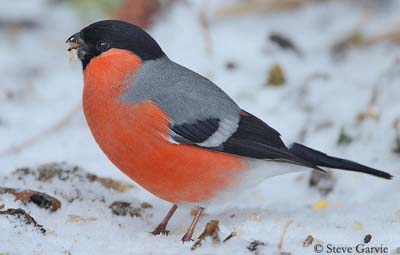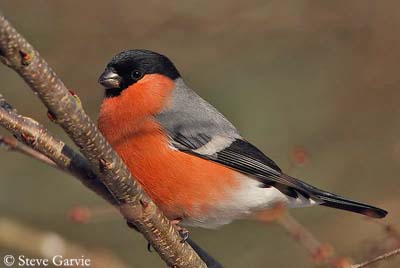
Eurasian Bullfinch
Pyrrhula pyrrhula
Passeriforme Order – Fringillidae Family
BIOMETRICS:
Length: 15-17 cm
Wingspan: 25 cm
Weight: 23 g
DESCRIPTION:
Eurasian Bullfinch is a bulky bull-headed bird. Male has grey mantle. Rump is white, contrasting with blackish tail. Wings are blackish with only one pale wing bar.
Underparts are pink-red, with white vent.
Fr: Eurasian Bullfinch
All : Gimpel
Esp : Camachuelo Común
Ital: Dómpápi
Nd: Noordse Goudvink
Russe: Обыкновенный снегирь
Sd: Domherre
Photographes:
Steve Garvie
RAINBIRDER Photo galleries
Nicole Bouglouan
PHOTOGRAPHIC RAMBLE
Texte de Nicole Bouglouan
Sources:
L’ENCYCLOPEDIE MONDIALE DES OISEAUX - Dr Christopher M. Perrins - BORDAS - ISBN: 2040185607
THE COMPLETE BOOK OF BRITISH BIRDS – Written by “Royal Society for the Protection of Birds” experts - Préface de Magnus Magnusson - Michael Cady- Rob Hume Editors - ISBN: 0749509112
THE HANDBOOK OF BIRD IDENTIFICATION FOR EUROPE AND THE WESTERN PALEARCTIC by Mark Beaman, Steve Madge - C.Helm - ISBN: 0713639601
Pájaros de España (JL Beamonte)
Animal Diversity Web (University of Michigan Museum of Zoology)
Wikipedia (Wikipedia, The Free Encyclopedia)
What Bird-The ultimate Bird Guide (Mitchell Waite)

Head has black crown, nape, lores and chin. Cheeks and throat are pink-red. Eyes are black. Crown is bluish-black with glossy feathers.
Short, conical low-based bill is blackish. Legs and feet ate pinkish-brown.
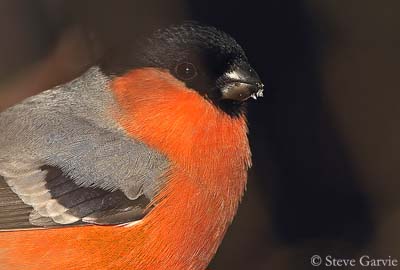
Female has grey-brown underparts and mantle, this one slightly darker than underparts.
Juvenile resembles adult female, but it lacks black on crown and around the bill. It has buff-brown wing bar.
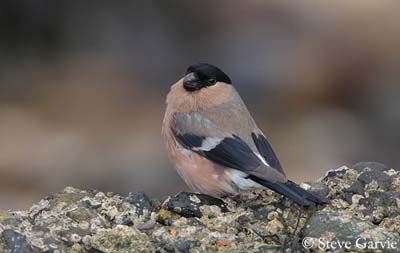
We have several species and subspecies of Bullfinch. Genus “Pyrrhula” has now 7 species, and “Pyrrhula pyrrhula” has 9 subspecies.
Pyrrhula p. pyrrhula is the largest bird. It lives in northern parts of the range.
Pyrrhula p. europaea is smaller than previous, and with duller plumage. It lives in western France to Denmark.
Pyrrhula p. pileata is similar in size with duller underparts than “europaea”. It lives in Great Britain.
Pyrrhula p. iberiae has brighter pink-red underparts, and females are paler and greyer than “europaea”. It lives in northern Spain and Portugal.
Pyrrhula p. griserventris has grey breast and red head. It is now a species. It lives in Japan.
Pyrrhula p. murina is much duller in colour. It doesn’t have white rump. It lives in forest edges at some altitude in Azores. They are in decline and endangered.
VOICE: SOUNDS BY XENO-CANTO
European Bullfinch’s usual call is a quiet, low, melancholy whistled “peeu” or “pew”.
Song is audible only at close range. It is a weak, scratchy warbling, alternating with soft whistles.
HABITAT:
European Bullfinch lives in woodlands, coniferous and deciduous, with dense undergrowth and in cultivated areas. It is also found in orchards, parks and gardens.
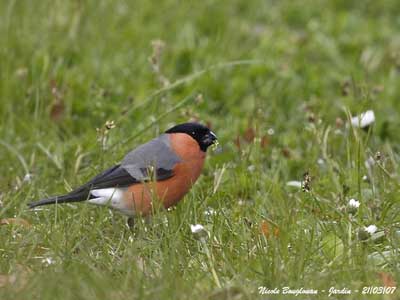
RANGE:
European Bullfinch is found from Europe to Asia and Japan. This species breeds across Europe and temperate Asia.
It is sedentary and resident, but northern birds migrate southwards in winter. They move short or medium distances.
BEHAVIOUR:
European Bullfinch is a shy and quiet bird. It is often seen flying from bush to bush. It is fond of buds in winter and spring, and causes important damages in orchards.
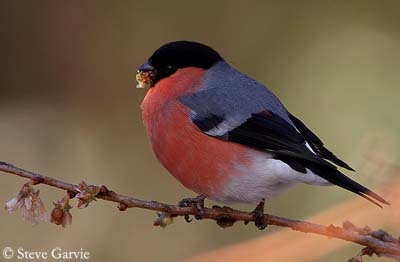
It is often seen in pairs or in small family groups. They perch mainly within the tree cover, rarely on the ground. In spring, they may form flocks of about 50 birds.
European Bullfinch feeds mainly on buds in spring. It lands on the tip of the branch where the buds are, and then, it moves slowly towards the trunk. They feed on buds when they lack seeds.
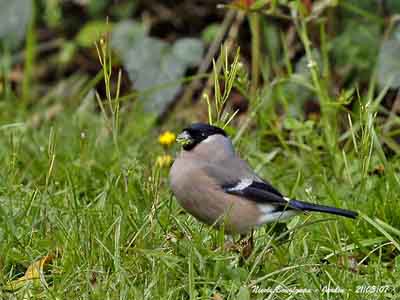
During nesting season, European Bullfinch brings food to the chicks, in special pouches situated at the base of the bill, on each side of the tongue. Most of the other Fringillidae carry food in their throat.
During courtship displays, male enhances the beautiful colour of its breast, with dropped wings in order to expose its white rump, while is waddling around female. Display may start with feigned attack from female to male, and pair is formed after this behaviour. There is no aggressivity between them.
Male walks sideways to female, with bill pointed at her and tail slightly sideward, until it touches the female’s bill. Then, it hops on the side and displays again, and both mates do it again together. They utter soft whistles during this courtship. Then, male regurgitates seeds into the female’s bill. She fluffs its feathers, bowing and turning from side to side.
When female builds the nest, male brings her twigs and rootlets.
Any behaviour of defence or territoriality has been observed. They nest solitary and silent.
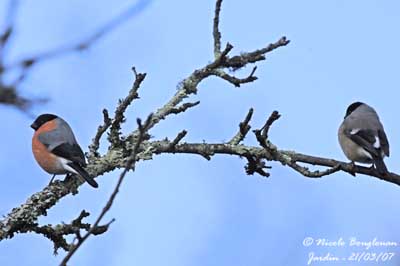
FLIGHT:
European Bullfinch performs a swift bounding flight, with rapid wing beats, alternating with brief period of closed wings. When flying longer distances, it has an undulating direct flight. It calls while it is flying.
REPRODUCTION:
European Bullfinch’s nest is built on a tree branch, or in a bush or thicket. Nest is located at about 1, 20 à 2 metres above the ground. It is a loose structure built by female, made with moss, twigs and lichens, and lined with hair, moss and roots.
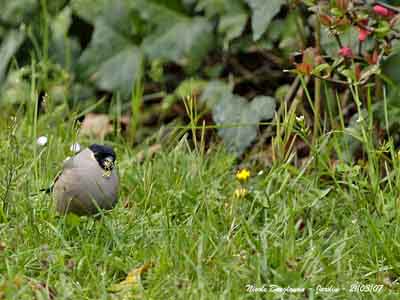
Female lays 4 to 6 pale blue eggs, mottled with red-brown. Incubation lasts about 12 to 14 days, by female helped and fed by male. Chicks are fed with a mixture of insects and seeds, brought at nest by the male. Later, both parents collect food for the young.
Young fledge at about 16 to 18 days.
This species produces two or three broods per season, from early May to mid-July.
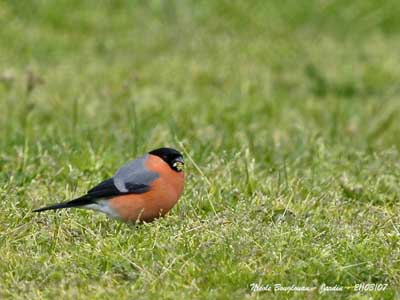
DIET:
European Bullfinch feeds mainly on seeds and buds of fruit trees. They also consume insects and berries.
PROTECTION / THREATS:
European Bullfinch is declining since recent times. Destruction of habitat with reduction of woodland edges and hedgerows may be responsible of this decline. It has removed nesting places and food resources.
The increased use of herbicides has impacted on Bullfinches.
Until 1996, they were often trapped as pests in orchards and farmlands. Now, it is only permitted under licence.
European Bullfinch has predators, such as Corvids and weasels.
